Andalucia is a great place to grow carrots depending on variety and time of year they are sown, will mature in 10 to 16 weeks
By Nick Nutter | Updated 30 Sep 2022 | Andalucia | Organic Garden |
Login to add to YOUR Favourites or Read Later


Mixed Carrots
I hope all you gardeners had a happy, and tasty, Christmas. By the end of December, the days are becoming noticeably longer. In Andalucia it is time to prepare the ground for the first sowings of the year and this month I will concentrate on the humble carrot. Before we get on to that though, here are the results of my Christmas experiments.
You may remember that the goal was to have new potatoes for Christmas. The seed potato was planted in a large pot in August. As the potato grew, compost was added to the pot to ‘earth up’ the potato. The pot was kept damp throughout. The foliage started to die back in mid-December and I emptied the pot. I had a few new potatoes, enough for one meal for Julie and myself. So, not a success.
I also planted a row of seed potatoes in the open ground in late September and those are coming along well. They look healthier than the one I grew in a pot.


Sprouts for Christmas
This was more successful. Julie sowed the seed in mid-April in a raised seed bed. The small plants were transplanted to the open ground in June. We have had sprout tops as an accompanying vegetable a couple of times during November and December, very tasty they are too. Topping the plants encourages the sprouts to swell. On Christmas Day I plucked the first sprouts. Not perhaps as large as those you find in supermarkets but with a fantastic mild flavour. They did not need any peeling. One of the beauties with sprouts is that, if you have the space, you can leave them in the ground and just pick the sprouts as you need them in the kitchen.
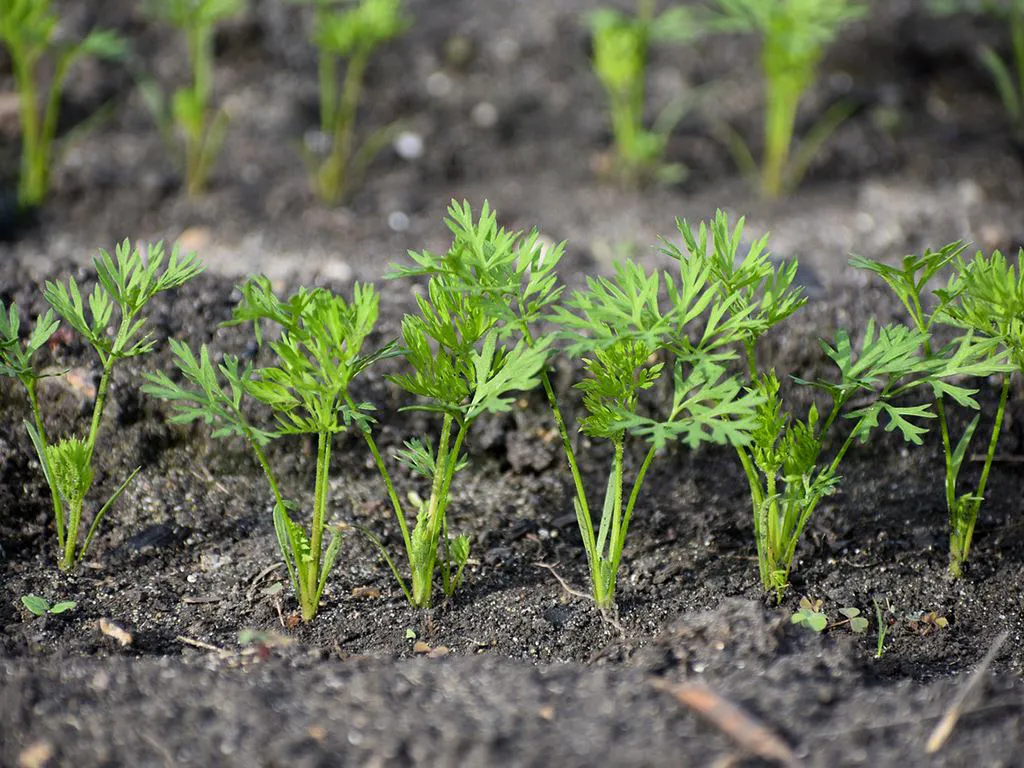
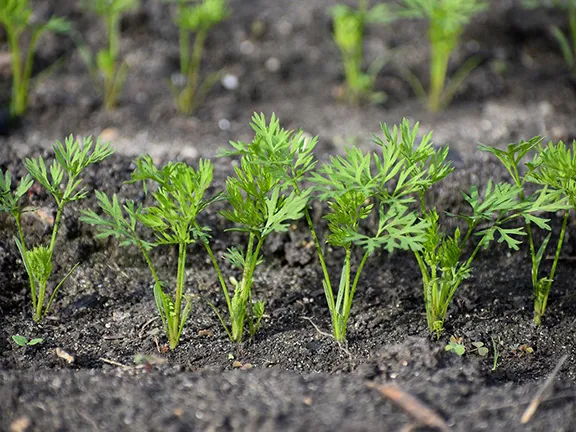
Carrots after thinning
Andalucia is a great place to grow carrots. If you are fanatical about this basic vegetable you can have them ready to pick and eat right through the year as long as you sow the right carrot at the right time. These days you can find the traditional orange carrots, the less traditional purple carrots, that are what wild carrots originally looked like, and even white carrots. You can find round carrots, stumpy rooted carrots, short carrots and long carrots. To a certain extent, the shape of the carrots you grow will be determined by the ground in which you grow them.
Carrots, depending on variety and time of year they are sown, will mature in 10 to 16 weeks.
Anybody that has grown carrots will have found some that have grown in all sorts of strange, twisted shapes and even some that have forked to produce two, three or more separate roots, all joined together. Whilst these weird carrots are fine to eat, they are a real pain to peel. Some supermarkets have even started selling deformed carrots claiming they are ‘organic’, implying that these strange shaped carrots are better for you and those wonky forms are more normal. Well, that is balderdash. Forked and twisted carrots, organically grown or not, have been grown in badly prepared ground. It’s as simple as that.
Carrots will grow in any ground, clay, sandy or loamy so long as the ground is not also stony or full of part composted twigs and other hard bits and you have prepared the ground. They prefer, above all else, a sandy, loamy soil so if your soil is clay then you should be adding sand and compost, if it is sandy then add compost and if it is loamy add sand.
Now, you may think that this is overkill just to get a crop of carrots. It is not. Most other root vegetables like the same conditions and you will be improving your ground for all the leaf and fruiting vegetables.
One of the main reasons carrots become bendy and forked is stones. The answer to that is simple enough. Remove the stones. If you have very stony ground you may have to consider growing carrots in raised beds. That is not a disaster, raised beds are great as you get older. You do not have to bend as far and tending the crops is so much easier. Raised beds that are made from four sides and no bottom are great, you can move them around the kitchen garden as you rotate crops.
Another reason carrots grow in odd shapes is excess nitrogen. This is where the ‘do not plant carrots in freshly manured ground’ rule comes from. In times past, farmers fertilized their fields by applying fresh animal manure direct from the barn. Fresh manure, cow, horse, pig or poultry, contains masses of nitrogen. Much of this disappears as the manure rots down and, traditionally, the first crop grown after manuring would be a leaf crop such as cabbage, that takes up nitrogen from the soil. Similarly, unrotted compost contains an excess of nitrogen. So, confine your addition of organic material to well-rotted compost and only enough to give you a crumbly, loamy finish.
How deep you should go depends on the type of carrot you intend to grow. If the carrot will grow to 20 centimetres, then that is the depth of soil that should be prepared, preferably a little more. One year I sowed a row of Chantenay carrots that normally grow to 13 – 15 cms. At least half matured at 30 cms. In my opinion, Chantenays are the best flavoured carrots, even if they do get a little over enthusiastic at times.
Finally, carrots do not like compacted ground so, once you have a fine tilth, create flat topped ridges wide enough for a double row of carrots, about 30 cms wide and 15 cms high, so that you are never treading on the prepared ground.
Certainly, in the first year, you should aim to grow carrots suited to the type of ground you started off with. If your soil was heavy clay, then a stumpy or round carrot will do best. If it was sandy then any of the long rooted carrots should do well.
Carrot seeds can take between 14 and 21 days to germinate and, because the seeds are very small, they have to be sown in shallow drills about 5mm deep. The trick is to keep the topmost layer of soil damp throughout the germinating period. So, once you have created your flat ridge, water it well, then make two, parallel, drills each 5 mm deep and 10 cms apart. Sow the seed thinly in the drills and cover with a thin layer of fine soil. Very lightly tamp the rows. I use the flat back of a rake. Then water again using a watering can, not the hosepipe.
Keep an eye on the ridges from day to day. In Andalucia you will likely have to dampen the top soil every couple of days in winter and every day in summer. Once the carrots have germinated the roots will extend down fairly quickly and pick up water from deeper in the ridge so you can reduce the frequency of watering accordingly.
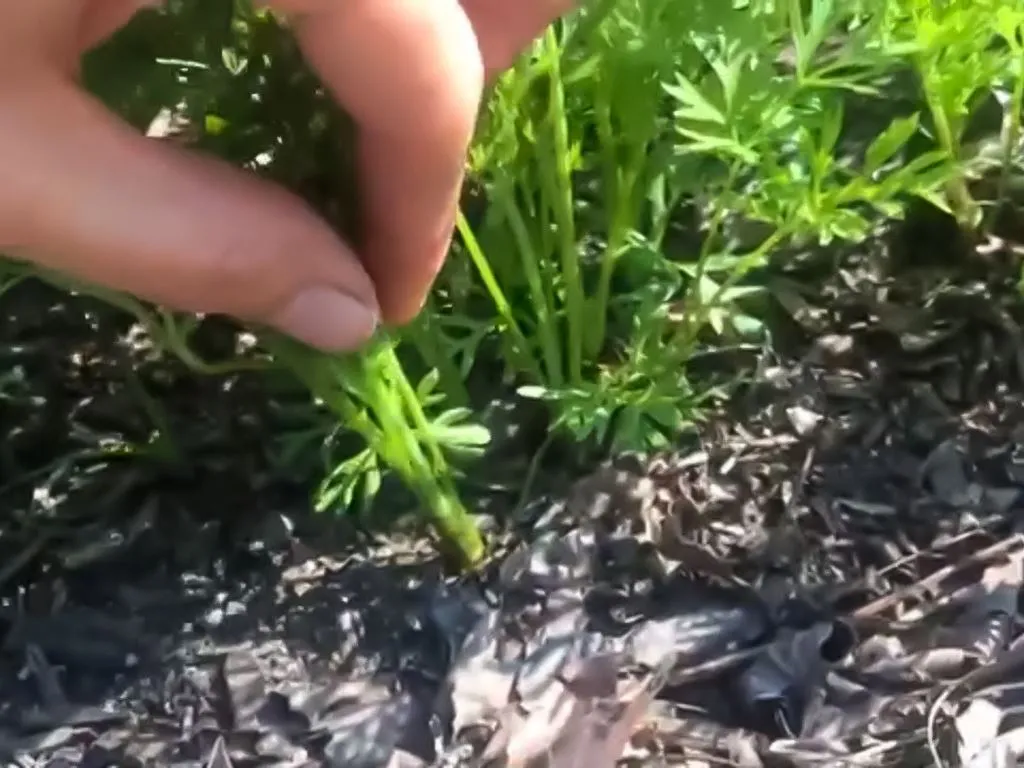
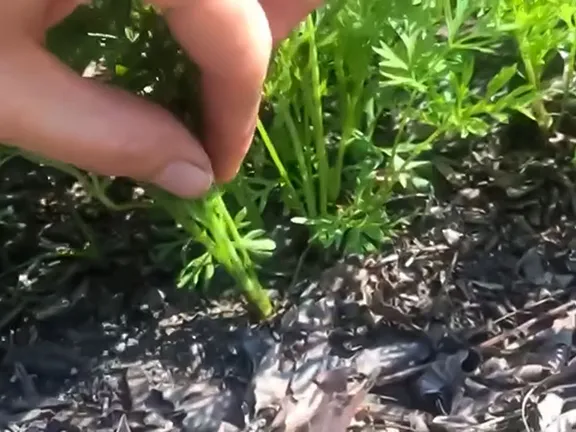
Thinning carrots
Ideally carrots should be thinned out twice.
When your carrots are about 8 cms high then they will need to be thinned out for the first time. Carrots do not like to have their roots disturbed so this first thinning to about 2.5 cms apart is quite a fiddly task, best done by hand. Despite the advice of other gardeners, it is not a good idea to use the thinnings to fill in gaps, they will in all probability either die or produce forked roots.
The second thinning takes place when the carrots themselves are about 1 cm wide at the top. Depending on the weather they will grow to this size 2 to 3 weeks after the first thinning. You can take out every other carrot so that you are left with plants about 5 cms apart. You should have a basket full of young carrots that are super in salads or cooked whole.
By this stage, the leafy growth should be shading the top of the ridge and you will be watering in the troughs between the ridges.
If you have prepared and kept the ground well, then grasping the stalks at the top of the carrot and gently tugging should release the carrot from the soil without disturbing the neighbouring roots. If the soil has become compacted, then you may have to use a hand fork to loosen the soil.
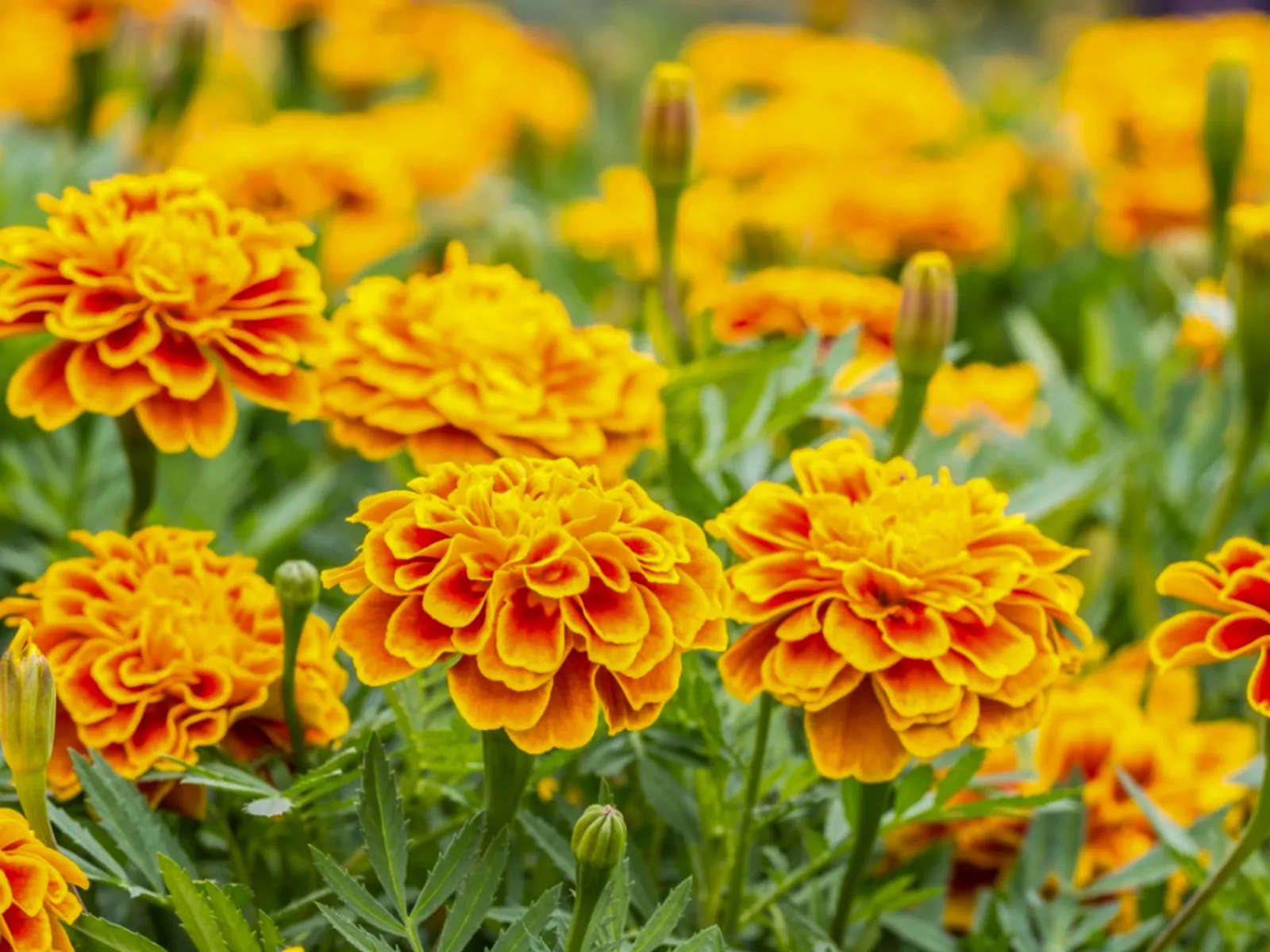

Marigolds
Carrots are not particularly susceptible to pests but two you should look out for are carrot fly and microscopic worms called nematodes.
Carrot fly lay their eggs near the carrots and the resulting larvae chomp away at your young carrots. The foliage will turn brown and the roots will be full of dark brown tunnels and holes. The carrots will be inedible.
Nematodes are not quite as bad. These minute worms also eat into the carrots. They can also cause the carrot to branch. If your freshly pulled carrots have small knots or galls, then in all probability the nematode has been at work. Fortunately, the carrot, unless very severely infected, is still edible. The nematode is a plant parasite completely harmless to humans.
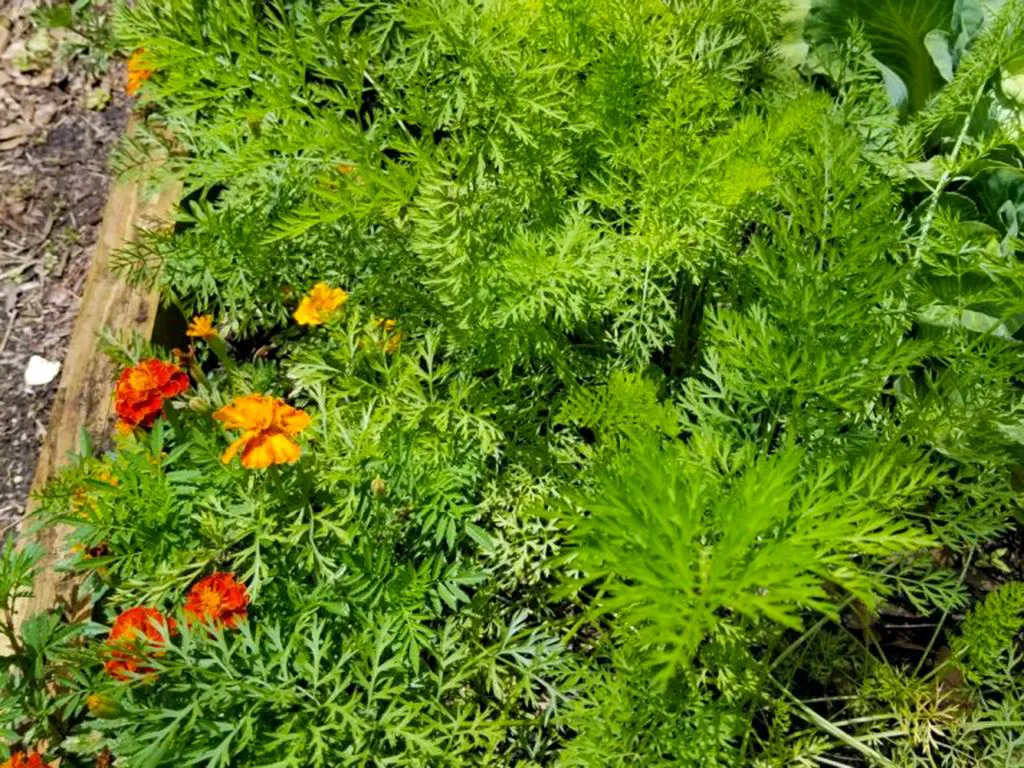
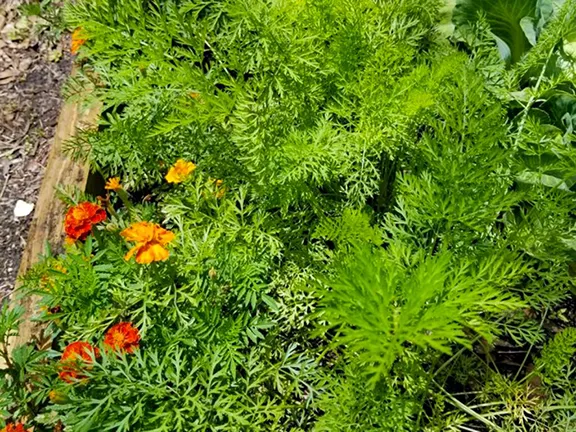
Carrots interplanted with marigolds
Interplanting is an interesting way of preventing or controlling pests on vegetables. The theory is that the pest is deterred by the perfume of the companion plant or its secretions.
The answer to both the carrot pests is to interplant with marigolds. Grow marigolds in the troughs between your carrot ridges. In fact, these marvellous, cheerful plants make good companions for all sorts of vegetables including basil, broccoli, cabbage, cucumbers, aubergines, pumpkins, kale, potatoes, squash and tomatoes.
They look nice as well.